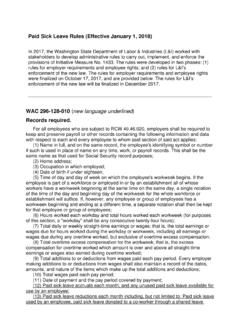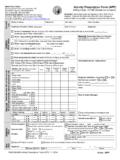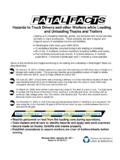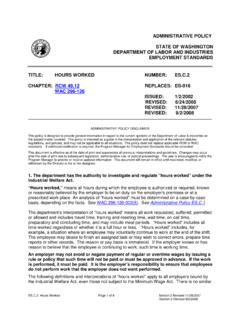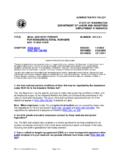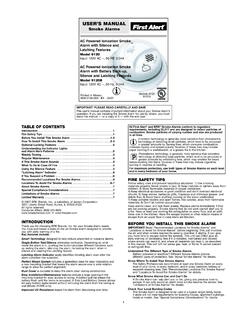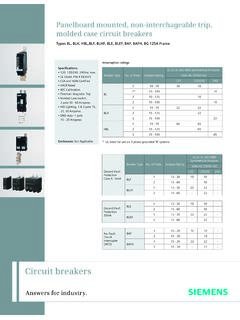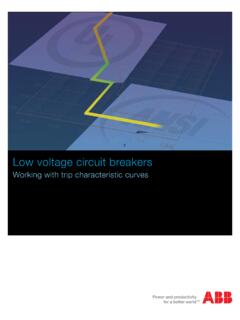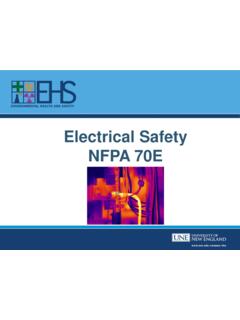Transcription of Homeowner’s Residential Electrical Inspection Guidelines
1 homeowner 's Residential Electrical Inspection Guidelines For you and your family's safety, if you are at all unsure of any of the information in this packet you are strongly urged to employ the services of a licensed Electrical contractor that utilizes certified individuals. In general, the law allows a homeowner to perform Electrical installation on his or her property without Electrical licensing or individual certification. Although this exemption exists it does not provide the homeowner with a realization of the potential safety hazards of a substandard Electrical installation.
2 The Departments experience with homeowner Electrical installations has led us to compile a list of the most common violations. This list is not comprehensive or inclusive. Successfully completing all items on this list will not cover everything that you will need to know to do a compliant installation. For information on a specific Electrical contractor or an electrician please visit our website at The # 1 Written Electrical Correction D NEC Failure to read the manufacturer's instructions. Services D WAC 296-46B-230 (3) The height of the service meter must be as required by the serving utility.
3 Contact the local utility to determine the requirements. D and NEC Except for mobile/manufactured homes a concrete encased grounding electrode (aka ufer ground) must be installed and used at each new building or structure that is built upon a permanent concrete foundation. The electrode must comply with NEC (A)(3). If a concrete encased electrode is not required and installed all premises Electrical services shall be connected to a grounding electrode system consisting of two 8' ground rods driven at least 6' apart, or a metal underground water pipe in direct contact with earth for m [10'] or more and bonded within 5 feet of entering the premises and supplemented by a rod, pipe, or plate electrode.
4 D NEC & The grounding electrode conductor shall be unspliced. The size is determined by the size of the service-entrance conductors D NEC A main bonding jumper or the green bonding screw provided by the panel manufacturer shall be installed in the service panel to electrically bond the grounded service conductor and the equipment grounding conductors to the service enclosure. D NEC The interior metal water piping and other metal piping that may become energized shall be bonded to the service equipment with a bonding jumper sized in accordance with (A)(1). D NEC Underground service laterals shall have their location identified by a warning ribbon placed in the trench at least 300 mm [12"] above the underground installation.
5 D NEC Conductors emerging from underground shall be installed in rigid metal conduit, intermediate metal conduit, or Schedule 80 rigid nonmetallic conduit to provide protection from physical damage. This protection shall extend from 450 mm [18"] below grade or the minimum cover distance to the point of termination above ground. D NEC The Electrical service disconnecting means shall be installed at a readily accessible location either outside a building or structure or inside nearest the point of entrance of the service entrance conductors. D NEC & Electrical panels shall be readily accessible and shall not be located in bathrooms or in the vicinity of easily ignitable materials such as clothes closets.
6 D NEC Sufficient-working space shall be provided around Electrical equipment. When the voltage to ground does not exceed 150 volts, the depth of that space in the direction of access to live parts, shall be a minimum of 900 mm [3']. The minimum width of that space in front of Electrical equipment shall be the width of the equipment or 750 mm [30"] whichever is greater. This workspace shall be clear and extend from the floor to a height of 2 m [6 ']. This space shall not be used for storage. D NEC Where exposed to weather, service entrance conductors shall be rain tight and arranged to drain.
7 D NEC Conductors of dissimilar metals shall not be intermixed in a terminal or splicing device unless the device is listed for the purpose. Listed anti-oxidant compound shall be used on all aluminum conductor terminations, unless information from the device manufacturer specifically states that it is not required D NEC Only one conductor shall be installed under a terminal screw. In boxes with more than one ground wire, the ground wires shall be spliced with a wire tail or pig tail attached to the grounding terminal screw of the device. General Circuitry D NEC and In addition to the branch circuits installed to supply general illumination and receptacle outlets in dwelling units, the following minimum requirements apply: D Two 20-amp circuits for the kitchen receptacles D One 20-amp circuit for the laundry receptacles D One 20-amp circuit for the bathroom receptacles D One separate, individual branch circuit for central heating equipment D NEC All conductors of the same circuit , including grounding and bonding conductors, shall be contained in the same raceway, cable, or trench.
8 D NEC All circuits and circuit modifications shall be legibly identified as to purpose or use on a directory located on the face or inside of the Electrical panel doors. D NEC and Receptacle outlets shall be of the grounding type, be effectively grounded, and have proper polarity. D NEC Generally, receptacle outlets in habitable rooms shall be installed so that no point measured horizontally along the floor line in any wall space is more than m [6'] from a receptacle outlet. A. receptacle shall be installed in each wall space 2 feet or more in width. D NEC At kitchen countertops, receptacle outlets shall be installed so that no point along the wall line is more than 600 mm [24"] measured horizontally from a receptacle outlet in that space.
9 D NEC A receptacle outlet shall be installed at each counter space 300 mm [12"] or wider, and at each island counter or peninsular space 600 mm [24"] by 300 mm [12"] or larger. Countertop spaces separated by, range tops, sinks or refrigerators are separate spaces D NEC Outdoor receptacles, accessible at grade level and no more than 2 m [ '] above grade, shall be installed at the front and back of a dwelling. Arc- fault (AFCI) Protection D NEC All branch circuits supplying 125-volt, 15 and 20-ampere outlets in dwelling units, except in garages and bathrooms shall be protected by a listed arc- fault circuit interrupter device.
10 Generally, these are circuit breaker type devices and cannot be installed on multi-wire branch circuits. All AFCIs shall be readily accessible (capable of being reached quickly without use of tools, climbing over or removing obstacles, or using portable ladders). Ground- fault (GFCI) Protection D NEC At dwellings, ground- fault circuit - interrupter (GFCI) protection shall be provided for the kitchen dishwasher branch circuit and for all receptacle outlets in bathrooms, garages, crawl spaces, unfinished basements, kitchen countertops, laundry areas, boathouses, outdoors and within 6 feet of sinks, bathtubs, and shower stalls.

